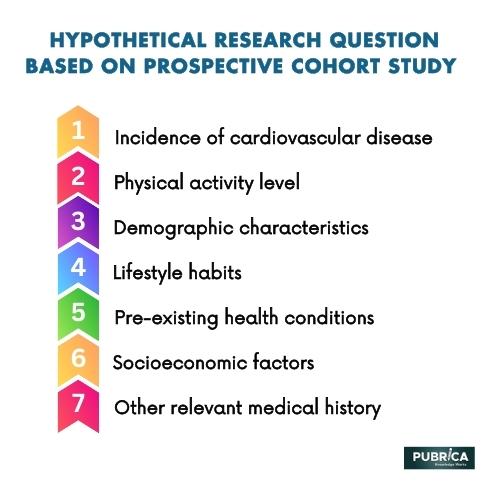
When I should think about Prospective Cohort Study
April 15, 2023
Is there a difference between the theoretical framework and conceptual framework of the study?
April 21, 2023In brief:
The specific data and statistical analyses appropriate for a hypothetical research project would depend on the research question and the data being collected. However, there are several general categories of data and statistical analyses that may be relevant, including descriptive statistics, inferential statistics, regression analysis, ANOVA, chi-square tests, factor analysis, cluster analysis, time series analysis, structural equation modelling, and machine learning techniques—in this blog discussed details about Possible Data and Statistical Analyses for the Hypothetical Research Question based on Prospective Cohort Study.
Introduction
To investigate the research question “Does regular physical activity reduce the risk of cardiovascular disease among middle-aged adults over a 10-year period, compared to those who are sedentary?”, the following data should be collected:
- Incidence of cardiovascular disease: Data should be collected on the incidence of cardiovascular disease among the study participants over 10 years, including the type and severity of the disease.
- Physical activity level: Data should be collected on the level of physical activity of study participants, including the type, frequency, and duration of physical exercise or activity performed over the 10 years.
- Demographic characteristics: Data should be collected on the age, gender, ethnicity, and other relevant demographic characteristics of study participants.
- Lifestyle habits: Data should be collected on lifestyle habits that may affect the risk of cardiovascular disease, including diet, smoking, and alcohol consumption.
- Pre-existing health conditions: Data should be collected on pre-existing health conditions that may increase the risk of cardiovascular diseases, such as hypertension, diabetes, and obesity.
- Socioeconomic factors: Data should be collected on socioeconomic factors that may affect the risk of cardiovascular diseases, such as income and education level.
- Other relevant medical histories: Data should be collected on any other relevant medical history that may affect the risk of cardiovascular diseases, such as the family history of cardiovascular disease, medication use, and history of previous cardiac events.

Collecting this data will allow researchers to investigate the relationship between physical activity and the risk of cardiovascular disease among middle-aged adults over 10 years while controlling for other relevant factors that may influence this relationship.
To analyze the relationship between regular physical activity and the risk of cardiovascular disease among middle-aged adults over 10 years, the following statistical analyses could be used:
- Descriptive statistics: Descriptive statistics, such as means, standard deviations, and frequencies, can be used to summarize the demographic, lifestyle, and health-related characteristics of the study population.
- Bivariate analysis: Bivariate analysis, such as chi-square tests, t-tests, or ANOVA, can be used to assess the relationship between physical activity and the incidence of cardiovascular disease, as well as to identify any significant differences in demographic, lifestyle, or health-related characteristics between physically active and sedentary individuals.
- Multivariate analysis: Multivariate analysis, such as logistic regression or Cox proportional hazards regression, can be used to examine the independent relationship between physical activity and the risk of cardiovascular disease while controlling for other relevant factors such as demographic, lifestyle, and health-related characteristics.
- Dose-response analysis: Dose-response analysis, such as meta-analysis or pooled analysis, can be used to examine the relationship between physical activity dose and the risk of cardiovascular disease.
- Subgroup analysis: Subgroup analysis, such as stratified analysis or interaction analysis, can be used to examine the relationship between physical activity and the risk of cardiovascular disease in different subgroups of the study population based on relevant characteristics, such as age, gender, or socioeconomic status.
- Sensitivity analysis: Sensitivity analysis can be used to assess the robustness of the study findings to potential sources of bias or confounding, such as selection bias, measurement error, or residual confounding (1).
The statistical analysis techniques will depend on the research question, data collection, and study design.
About Pubrica
Pubrica’s team of researchers and writers generates scientific and medical research articles that might be significant resources for practitioners and authors. Pubrica medical writers aid you in creating and rewriting the introduction by informing the reader of the gaps in the selected research field. Our experts know the sequence in which the broad topic, issue, and background are followed by the subject in which the hypothesis is given.
References
Celis-Morales, Carlos A., et al. “Association between active commuting and incident cardiovascular disease, cancer, and mortality: prospective cohort study.” bmj 357 (2017): j1456.
